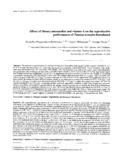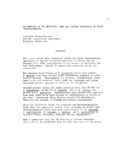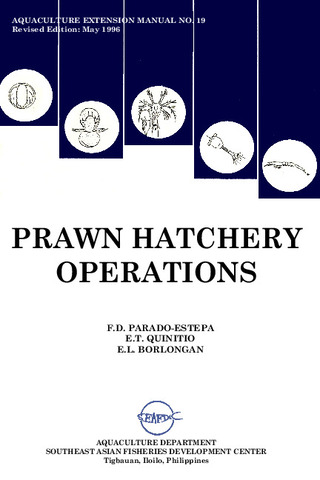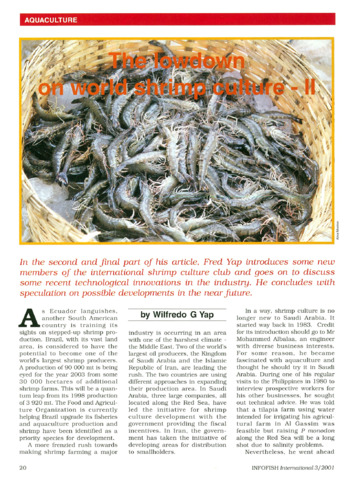Effect of dietary astaxanthin and vitamin A on the reproductive performance of Penaeus monodon broodstock
- Global styles
- MLA
- Vancouver
- Elsevier - Harvard
- APA
- Help

View/
Date
1998Page views
1,628ASFA keyword
AGROVOC keyword
Taxonomic term
Metadata
Show full item record
Share
Abstract
The reproductive performance of pond tiger shrimp given astaxanthin (100 mg·kg−1) and/or vitamin A (20 000 IU·kg−1) for 61 d in tanks was assessed in a 2 × 2 factorial experiment in a completely randomized design. Tissue carotenoid (total carotenoid; astaxanthin free form. AF; monoester, AM; diester, AD) was analyzed using high performance liquid chromatography. The gonad index (GI) of shrimps fed diets with astaxanthin and/or vitamin A (3.05 ± 0.11 to 3.30 ± 0.17) were significantly higher than shrimps not fed any supplement (2.24 ± 0.17). A significant interaction between astaxanthin and vitamin A for ovarian development and spawning was detected (GI, 3.18 ± 0.14). The ovarian total carotenoid (10.85 ± 1.52 μg·g−1) and astaxanthin (AF, 7.65 ± 1.43 μg·g−1; AM, 0.63 ± 0.12 μg·g−1) content of shrimps fed a diet with astaxanthin supplement were significantly higher than those without. In shrimps fed diets with and without vitamin A, no differences in ovarian total carotenoid (9.38 ± 0.58 μg·g−1) and AF (8.12 ± 1.55 μg·g−1) content were observed except for AM (0.64 pm 0.15 μg·g−1) content. In contrast, the ovarian AD level was significantly higher (1.14 ± 0.3 μg·g−1) in shrimps fed diets with both supplements compared to other diets. A significant interaction between astaxanthin and vitamin A was detected for AD storage. In the hepatopancreas of shrimps fed diets with or without astaxanthin or vitamin A, no significant differences in AF and AM content was observed. On the other hand, the AD (4.92 ± 1.3 μg·g−1) level in the hepatopancreas of shrimps fed diet with vitamin A was significantly higher than those without. These results suggest the involvement of astaxanthin in P. monodon reproduction and its need for inclusion in broodstock diets. Supplementation of vitamin A to broodstock diet of P. monodon appears to enhance its ovarian development and spawning.
Suggested Citation
Pangantihon-Kühlmann, M. P., Millamena, O., & Chern, Y. (1998). Effect of dietary astaxanthin and vitamin A on the reproductive performance of Penaeus monodon broodstock. Aquatic Living Resources , 11(6), 403-409. https://doi.org/10.1016/S0990-7440(99)80006-0
Type
ArticleISSN
0990-7440Collections
- Journal Articles [1258]
Related items
Showing items related by title, author, creator and subject.
-
An overview of the nutrition, feed and feeding techniques of prawn penaeid/shrimps
Piedad-Pascual, Felicitas (Philippine Council for Aquatic and Marine Research and Development, 1989)This paper echoes what transpired during the first International Conference of Penaeid Prawns/Shrimps held in Iloilo City in December 4-7, 1984, particularly on the Nutrition nd Feed Development. Around 25 papers were ... -
Series: Aquaculture extension manual; No. 19
Prawn hatchery operations
Parado-Estepa, Fe D.; Quinitio, Emilia T. ; Borlongan, Emeterio L. (Aquaculture Department, Southeast Asian Fisheries Development Center, 1996-05)
The manual, an updated version of the 1984 SEAFDEC/AQD manual, presents the underlying principles and step-by-step instructions of prawn larval and post-larval rearing. The techniques described are not only applicable to ...
; Borlongan, Emeterio L. (Aquaculture Department, Southeast Asian Fisheries Development Center, 1996-05)
The manual, an updated version of the 1984 SEAFDEC/AQD manual, presents the underlying principles and step-by-step instructions of prawn larval and post-larval rearing. The techniques described are not only applicable to ... -
The lowdown on world shrimp culture - II
Yap, Wilfredo G. (INFOFISH, 2001)This paper introduces some new members of the international shrimp culture club and goes on to discuss some recent technological innovations in the industry, particularly the polyculture of tilapia (mainly Oreochromis ...





